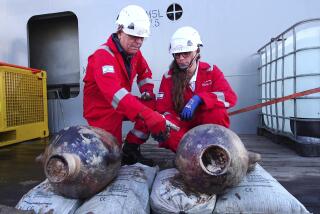Discovery Lends Credence to Account of Noah’s Flood
U.S. archeologists have found the remains of a 7,500-year-old building, probably a house, more than 300 feet below the surface of the Black Sea, the strongest evidence yet of a catastrophic flood similar to the one portrayed in the biblical account of Noah’s ark.
Last November, explorer Robert Ballard, famed as the discoverer of the Titanic, reported evidence of a submerged shoreline several miles offshore from the current edge of the Black Sea and hundreds of feet below the surface.
The newly found house appears to have been on that beach.
“Now we know that people were living on that surface when [the flood] took place, because we are finding evidence of human habitation,” Ballard said Tuesday in a telephone interview with the Washington Post from his ship 12 miles off the Turkish coast.
“This is amazing. It’s going to rewrite the history of ancient civilizations because it shows unequivocally that the Black Sea flood took place and that the ancient shores of the Black Sea were occupied by humans,” said marine geologist William B.F. Ryan of Columbia University. “This is a stunning confirmation of our thesis.”
Ryan and his colleague Walter C. Pittman III have argued--first in a series of research articles and ultimately in a book published last year called “Noah’s Flood”--that rising waters in the Earth’s oceans caused the Mediterranean to crash through a natural earth dam blocking what is now the Bosporus Strait.
For as long as two years, water rushed through the narrow Bosporus with the flow of 200 Niagara Falls, eventually inundating an area the size of Florida.
They argued that residents who fled the area carried stories that eventually were incorporated into the flood stories that seem to permeate cultures worldwide.
Ballard’s team found the rectangular structure 311 feet below the sea’s surface about 12 miles east of the Turkish city of Sinope.
The construction material of the 39-by-13-foot structure was identified as traditional Black Sea “wattle and daub” architecture: wood branches and sticks embedded in a clay matrix.
“This struck a bell because it was familiar to me from [ancient buildings on] land,” said archeologist Fredrik Hiebert of the University of Pennsylvania, part of Ballard’s team. “Literally, my jaw dropped.”
The team made the finding three days ago, in the second week of a planned five-week expedition. The expedition also found old tree branches, pieces of wood and a trash heap with polished stones and other debris indicating human habitation, Ballard said.
Nearby, they discovered two old shipwrecks containing ceramic amphorae, large clay vessels used for transporting olive oil, wine and other materials. The team is not yet sure if the wrecks are from the same period or later.
The team photographed the structure and recovered some artifacts from the site using a remote-controlled submersible called Argus that is not much bigger than a washing machine. It is connected to the ship by fiber-optic cables.
The artifacts were extremely well preserved for their age because the depths of the Black Sea have a very low oxygen level--too low to support the marine worms and bacteria that normally would destroy wood, sails and other materials.
Ballard long has argued that this anoxic environment should make the floor of the Black Sea a literal museum containing the preserved hulks of hundreds or even thousands of ancient vessels. He plans to begin exploring the sea floor after he examines the immediate area of the newly discovered house to see if more dwellings lie nearby.
“Now we are looking for neighbors,” he said.
Biblical scholars believe that the Book of Genesis and the story of Noah’s flood were written about 2,500 to 2,900 years ago, nearly five millenniums after the Black Sea flood. Many have questioned whether the biblical events could be tied to a single ancient event.
But Ryan and Pittman argued that the exodus from the shores of the ancient sea was so traumatic to its populace that it was recorded in the collective human memory as the story of Noah, in the Babylonian epic of Gilgamesh, and in a variety of other flood stories.
“If you want to say the Black Sea flood is Noah’s flood, who is to say no?” said archeologist Hershel Shanks, editor of the Biblical Archeology Review.
Ballard’s expedition is sponsored by the National Geographic Society, the Office of Naval Research, the National Oceanic and Atmospheric Administration, the J.M. Kaplan Fund and the University of Pennsylvania.






